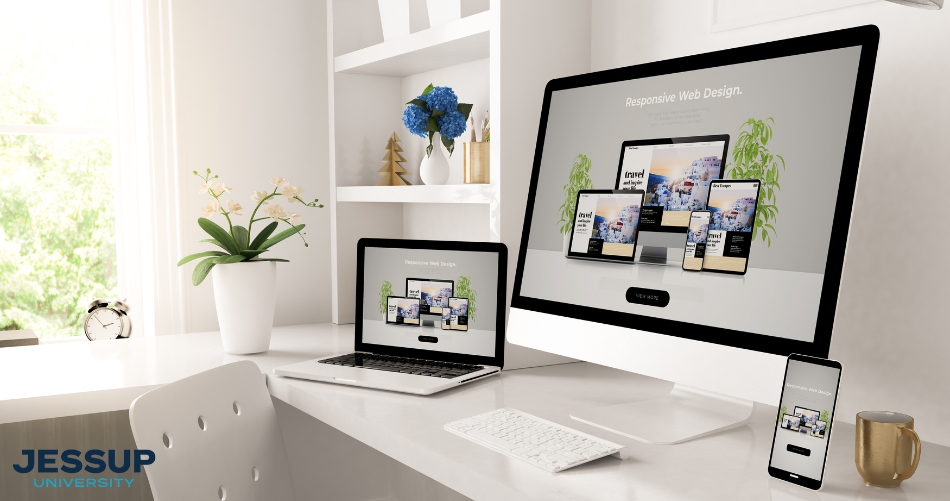Branding and web design elements that engage with target audiences
Uncovering the Uses of Web Design for Enhancing Individual Experience
Web layout substantially influences customer experience across digital platforms. By focusing on individual demands, designers produce web sites that are not just aesthetically appealing however likewise practical and obtainable. Trick aspects such as receptive layout and instinctive navigation play essential duties in enhancing functionality. The difficulty exists in comprehending exactly how these components communicate to meet advancing customer assumptions. The exploration of these variables reveals understandings that could change electronic interaction.
Recognizing User Requirements and Expectations
Just how can Web designers successfully straighten their productions with customer demands and assumptions? To accomplish this, designers need to participate in extensive customer study to record the choices, behaviors, and discomfort factors of their target audience. Using methods such as surveys, interviews, and use testing, designers gather valuable understandings that direct their decision-making process.
Producing individual characters can additionally aid in envisioning different customer sectors, guaranteeing that style selections reverberate with genuine customers. Additionally, designers should prioritize instinctive navigating and clear contact us to action, which promote smooth interactions.
The Relevance of Responsive Style
As customers increasingly accessibility websites on a range of tools, responsive design has become essential for creating a favorable individual experience. This strategy enables website to adapt effortlessly to different display sizes, ensuring that web content is conveniently understandable and navigable, no matter of whether a customer is on a tablet computer, smart device, or desktop .
Receptive layout enhances usability by offering a consistent experience, minimizing the requirement for excessive scrolling or zooming. In addition, search engines favor responsive internet sites, which can improve a site's visibility and reach. This design approach also enhances advancement initiatives, as it gets rid of the requirement for multiple versions of a site tailored to particular devices.
Incorporating receptive design not only satisfies user assumptions however additionally straightens with modern Web requirements, cultivating engagement and fulfillment. Ultimately, it indicates a dedication to access and inclusivity, critical components for any kind of effective online visibility.
Creating Instinctive Navigation
An effective Web style not only incorporates receptive layouts however likewise prioritizes intuitive navigating, which is essential for directing users with a site seamlessly. Instinctive navigation warranties that users can conveniently find info without unneeded effort. Crucial element consist of a clear menu framework, logical categorization of material, and identifiable icons or labels.
Consistency in navigation positioning across different pages promotes experience, enhancing individual convenience. Using breadcrumb tracks permits customers to track their area within the site, helping in backtracking and exploration. On top of that, enhancing navigation for mobile phones is fundamental, as lots of users accessibility sites using smart devices and tablets.
Integrating a search bar can in addition enhance the individual experience, making it possible for quick accessibility to particular content. In general, instinctive navigation minimizes disappointment, urges longer site visits, and inevitably results in higher individual satisfaction and interaction. By concentrating on navigating design, Web developers can considerably enhance the overall individual experience.
Making Use Of Aesthetic Pecking Order Properly
Reliable website design pivots on the calculated usage of aesthetic hierarchy, guaranteeing that individuals can effortlessly browse content and realize the most crucial information at a look. By prioritizing elements based on their significance, designers can direct customers' attention towards critical areas, such as headings, calls-to-action, and crucial pictures.
Strategies such as size, comparison, placement, and color play vital functions in developing this hierarchy. For instance, larger text frequently indicates greater value, while contrasting colors can draw focus to essential actions. In addition, regular placement and spacing assistance produce an organized format, making it simpler for users to process information promptly.
Incorporating images tactically can enhance understanding and retention of web content. When made use of properly, a well-defined visual hierarchy not only improves use yet also improves the total individual experience, allowing customers to engage meaningfully with the internet site's goals.
Enhancing Readability and Accessibility
Aesthetic power structure substantially influences how individuals interact with a web site, but just as important is guaranteeing that material stays understandable and easily accessible to all audiences. Effective website design employs clear typography, including suitable font sizes, line spacing, and comparison to improve readability. The usage of high-contrast color design can assist those with aesthetic impairments, while bigger text dimensions profit individuals with reviewing problems. In addition, including alt text for photos guarantees that people making use of screen viewers can access essential details.
Designers must likewise take into consideration the layout and structure of material, making use of headings and bullet indicate separate huge blocks of text. This not just help skimming however also assists individuals with cognitive specials needs. Eventually, prioritizing readability and availability fosters an inclusive environment, enabling diverse article audiences to engage totally with the website's web content (website development). By resolving these components, Web developers can significantly boost click this link the total individual experience
Incorporating Involving Aesthetic Aspects
Integrating interesting aesthetic elements is essential for boosting individual experience in Web layout. Color psychology plays a substantial role in affecting users' emotions and behaviors, while interactive graphics can capture interest and encourage expedition. Together, these aspects develop a more appealing and vibrant online environment.
Significance of Color Psychology
The relevance of shade psychology in website design can not be overstated, as it plays a necessary role fit individual assumptions and behaviors. Colors stimulate feelings and can affect exactly how customers interact with a web site. For circumstances, blue often shares count on and professionalism and reliability, making it a preferred choice for financial organizations. Alternatively, red can trigger urgency and exhilaration, often utilized in sales promos. Understanding the psychological results of color makes it possible for developers to create a cohesive visual experience that reverberates with individuals. Furthermore, regular color design enhance brand name identity and acknowledgment, guaranteeing customers link particular shades with specific brands. Ultimately, thoughtful application of color psychology can significantly enhance customer interaction and satisfaction, making it a basic aspect of effective website design.
Making Use Of Interactive Graphics
Involving users with interactive graphics can significantly boost their total experience on a website. These elements, such as computer animations, infographics, and clickable visuals, promote a much deeper connection between customers and the web content. By encouraging expedition and engagement, interactive graphics can make complicated details more digestible and keep users' interest much longer. In addition, they offer a possibility for individuals to interact with the site in a meaningful way, leading to enhanced complete satisfaction and a higher probability of returning. It is essential to stabilize interactivity with use; excessively intricate graphics might puzzle customers. Properly executed, interactive graphics can change a passive watching experience into an appealing trip, eventually contributing to improved user experience and site performance.
Continuous Checking and Enhancement Strategies
Continuous testing and renovation methods offer as important elements in enhancing Web design for customer experience. By applying repetitive screening, developers can collect real-time comments on individual interactions, allowing them to determine discomfort points and areas for improvement - branding. A/B testing, usability screening, and warmth mapping are reliable techniques that provide insights into customer habits, making it possible for enlightened style decisions
Additionally, these methods encourage a culture of ongoing refinement, instead than an one-time launch. Web developers can utilize analytics devices to keep an eye on performance metrics, such as bounce prices and conversion prices, which assist needed moved here changes. Routine updates based upon customer feedback not just improve capability but also foster user contentment and loyalty.
Eventually, continuous testing and improvement create a receptive Web style atmosphere where individual experience is prioritized, ensuring that the website progresses alongside customer needs and technical improvements. This aggressive technique results in a much more interesting and efficient online visibility.
Often Asked Concerns
How Can Shade Psychology Influence Individual Experience in Website Design?
Color psychology greatly influences customer experience in website design by stimulating emotions and leading behavior. Different shades can produce associations, enhance readability, and impact individual interaction, ultimately forming perceptions of a brand name or web site's functionality.
What Role Does Typography Play in Individual Involvement?
Typography substantially affects user engagement by enhancing readability, developing power structure, and communicating brand individuality. Reliable typeface choices can capture interest, stimulate feelings, and guide customers via web content, eventually boosting general communication and satisfaction with the website.

How Do Social Differences Impact Web Layout Preferences?
Cultural distinctions greatly influence Web design choices, influencing shade choices, images, navigation, and layout designs. Understanding these variants enables designers to create even more engaging and relatable experiences tailored to varied individual histories and assumptions.

What Devices Can Help Examination Individual Experience Efficiently?
Various tools, consisting of Google Analytics, Hotjar, and UsabilityHub, effectively test customer experience. These systems offer insights into individual habits, promote A/B screening, and collect responses, helping designers make informed choices to boost overall use.
Just how Often Should a Site Be Revamped for Optimum Individual Experience?
A web site must be redesigned every a couple of years to maintain perfect individual experience. Normal updates assure the style stays modern, receptive, and aligned with progressing user requirements and technical developments, boosting general involvement.
Developing individual identities can even more aid in picturing different individual segments, guaranteeing that design choices reverberate with real individuals. As customers significantly access websites on a range of gadgets, receptive style has actually become crucial for creating a positive user experience. Incorporating engaging aesthetic components is necessary for improving customer experience in Web layout. Eventually, continual testing and improvement produce a responsive Web style environment where customer experience is focused on, guaranteeing that the website advances alongside user demands and technical advancements. Shade psychology significantly influences customer experience in Web layout by assisting and evoking feelings behavior.